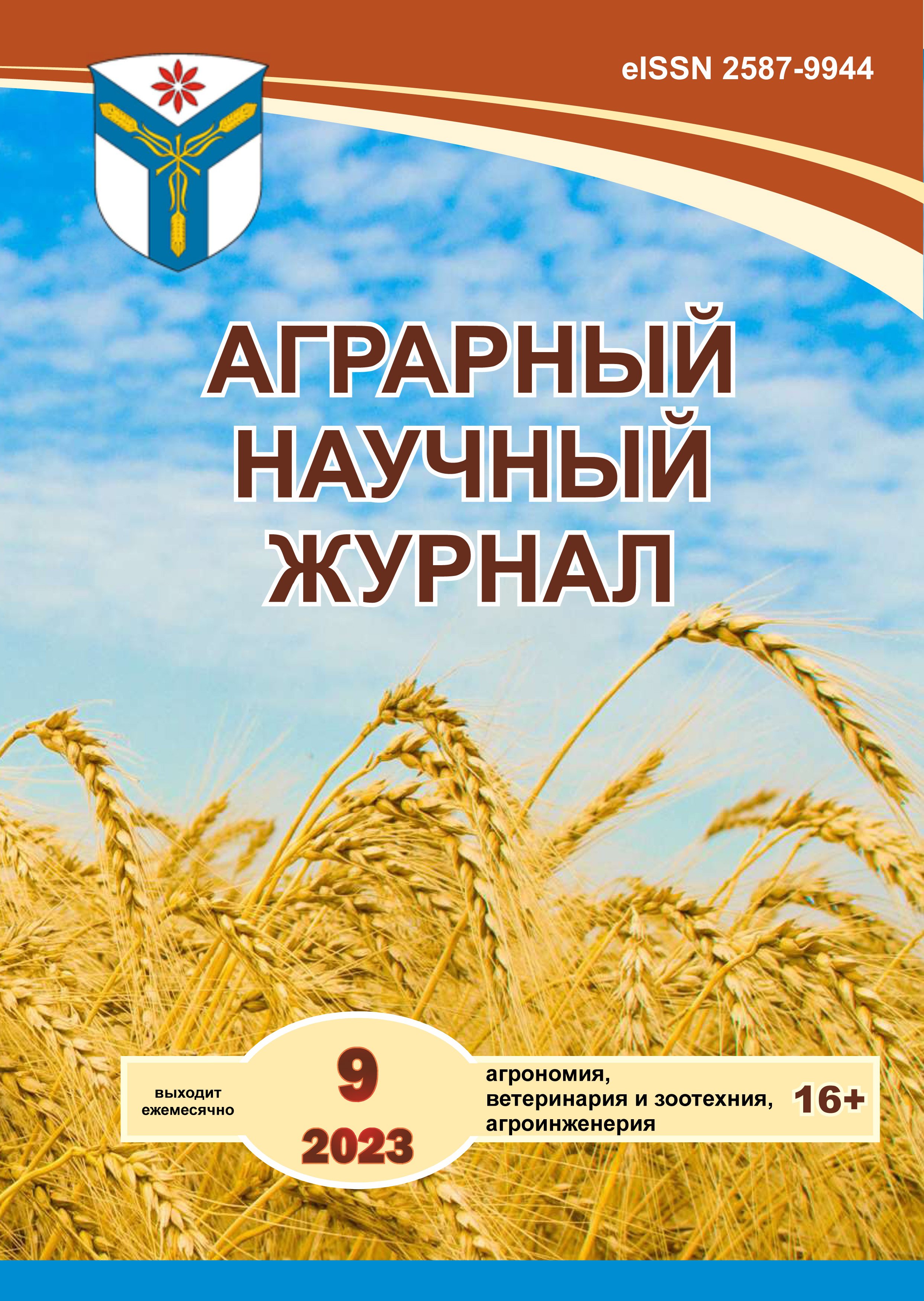Technology of cultivation of winter wheat in the steppe zone of RNO-Alania
DOI:
https://doi.org/10.28983/asj.y2023i9pp39-45Keywords:
winter wheat, varieties, growth regulators, productivity, efficiencyAbstract
The authors present the results of the use of growth biological preparations on winter wheat crops in the steppe zone of the Republic of North Ossetia-Alania. The purpose of the study is to increase the yield of winter crops with high quality indicators of food grain through the use of biological products - Edagum SM (450 ml/ha); Furolan Zh (5.1 ml/ha); Vitazim BP (1.0l/ha). Novelty. For the first time in the conditions of the steppe zone, the scientific basis for the use of biological agents aimed at improving the quality and yield of winter wheat has been developed. Methodology. The research was carried out in 2020-2022 on the experimental fields of the Vladikavkaz Scientific Center of the Russian Academy of Sciences, located in the Mozdok region of North Ossetia-Alania. The soils of the experimental plot are carbonate-chestnut. In terms of mechanical composition, they are classified as heavy loamy coarse silt. The chemical composition of chestnut calcareous soils is quite favorable for the cultivation of agricultural crops. The content of humus, depending on the mechanical composition, ranges from 2.22 to 3.45 %. The introduction of growth regulators made it possible to obtain a high yield with quality indicators of grain. The use of the biological product Edagum SM, in terms of yield, turned out to be the best, where the increase in comparison with the control for the Grom variety was 1.31 t/ha, Furolan Zh - 0.99 t/ha, Vitazim VR - 0.69 t/ha. For the Yumpa variety - 1.35 t/ha, 0.99, 0.77 t/ha, respectively. By treating plants with biological preparations, the quality indicators of winter wheat grain are improved, where the gluten content of the studied varieties increases by 4.4 %, the increase in gluten with the use of Furolan Zh biological preparations by 4.0 % and Vitazim VR by 1.2 %. Using the drug Edagum SM profitability increased by 48 %, Furolan Zh increased the level of profitability by 35.7 %, Vitazim VR by 17.7 %. For the Yumpa variety, when growth regulators are introduced, the level of profitability increases from 24.3 to 50.3 % compared to the control.
Downloads
References
Абаев А.А., Тедеева А.А., Мамиев Д.М., Тедеева В.В. Влияние сроков посева на продуктивность различных сортов сои // Научная жизнь. 2016. № 5. С. 33-42.
Адиньяев Э.Д., Халилов М.Б. Влияние предшественников на продуктивность озимой пшеницы при многослойной обработке почвы // Известия Горского государственного аграрного университета. 2018. Т. 55. № 2. С. 7-13.
Бакулова И. В., Плужникова И. И., Криушин Н. В. Эффективность применения гуминового препарата при возделывании конопли посевной // Аграрный научный журнал. 2021. № 10. С. 8–12.
Галушко Н.А., Соколенко Н.И. Важнейшие критерии отбора на качество зерна в селекции озимой пшеницы // Таврический вестник аграрной науки. 2021. № 4 (28). С. 50-57.
Иванченко Т.В., Игольникова И.С. Влияние регуляторов роста на продуктивность и качество зерна озимой пшеницы в условиях Нижнего Поволжья // Известия Нижневолжского агроуниверситетского комплекса: Наука и высшее профессиональное образование. 2018. № 1 (49). С. 101-108.
Ибрагимов А.А., Голосной Е.В., Устименко Е.А., Коростылёв С.А., Сигида М.С. Оценка эффективности ранневесенней азотной подкормки на урожайность и качество озимой пшеницы в условиях Ставропольского Края // Политематический сетевой электронный научный журнал Кубанского государственного аграрного университета. 2021. № 173. С. 40-48
Кисс Н.Н., Мищенко А.Е. Технология возделывания озимой пшеницы ресурсосберегающая агротехнология возделывания озимой пшеницы на эрозионно-опасных склонах черноземов обыкновенных // Фермер. Поволжье. 2016. № 4 (46). С. 42-47.
Мамсиров Н.И. Совершенствование некоторых элементов агротехники возделывания озимой пшеницы // Аграрная Россия. 2018. № 6. С. 9-12.
Мамсиров Н.И., Мнатсаканян А.А. Эффективность разных доз минеральных удобрений под озимую пшеницу // Новые технологии. 2021. Т. 17. № 3. С. 77-85.
Сибикеев С. Н., Дружин А. Е., Андреева Л. В. Изучение эффектов снижения отрицательного влияния 1ВL-1RS-транслокации на качество муки и хлеба у линий яровой мягкой пшеницы // Аграрный научный журнал. 2021. № 6. С. 27–33
Тедеева А.А., Хохоева Н., Абаев А.А., Тедеева В., Мамиев Д.М., Мамиев Д.М., Лагкуева Э.А. Оптимизированные элементы технологии возделывания чины посевной в условиях предгорной зоны Центрального Кавказа // Владикавказ, 2017. 39с.
Шалыгина А.А., Тедеева А.А. Влияние регуляторов роста на структуру урожая озимой пшеницы // Аграрная наука. 2021. № 4. С. 64-67.
Downloads
Published
Issue
Section
License
Copyright (c) 2023 The Agrarian Scientific Journal

This work is licensed under a Creative Commons Attribution-NonCommercial-NoDerivatives 4.0 International License.








